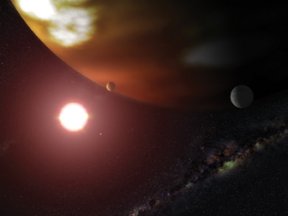Using a decades-old technique, astronomers have precisely measured the mass of a planet outside our solar system. The measurement reveals that the unseen planet, which orbits a star just 15 light-years from Earth, weighs between 1.9 and 2.4 times the mass of Jupiter. Previous estimates placed the planet’s mass between 1.9 and 100 times that of Jupiter.


By measuring the mass of an extrasolar planet so precisely, theorists can better understand how planets form, note G. Fritz Benedict and Barbara McArthur of the University of Texas at Austin. They and their collaborators describe their findings in the Dec. 20 Astrophysical Journal Letters.
The team relied on a technique called astrometry, which measures the motion of a star across the sky due to the tug of a companion–either a planet or another star. Although astronomers have employed the technique for 4 decades, their instruments only had the sensitivity to clearly detect a companion star.
Now, using one of the star-targeting systems on the Hubble Space Telescope, the astronomers have measured changes in a star’s position as small as 1 percent of the distance between the sun and Mercury.
A different method, which measures changes in the velocity of a star as it wobbles along the line of sight to Earth, previously detected more than 100 extrasolar planets. These include two that orbit Gliese 876, the star that Benedict’s team also studied.
However, the wobble method measures changes in only one component of the star’s velocity, so it can’t reveal the true mass of an orbiting companion, only a lower limit. For the outer planet of Gliese 876, other methods provided a high upper limit.
In contrast, astrometry maps the changing position of a star. This enables astronomers to determine the tilt of a presumed planet’s orbit relative to Earth and therefore the body’s mass, rather than just a lower limit. “Until you do astrometry, you can’t be sure that a planet really is a planet,” says Benedict.
Because a star and its planet orbit a common center of mass, astrometry works best when the parent star has a relatively low mass and the planet isn’t too close to the star. In these cases, the star makes the greatest excursion across the sky and is easiest to detect.
Benedict’s team focused on Gliese 876 because it weighs only one-third as much as the sun and has an outlying planet.
Astronomers have determined the exact mass of one other extrasolar planet (SN: 11/20/99, p. 324: http://www.sciencenews.org/sn_arc99/11_20_99/fob1.htm). The new find “is significant not only in its own right but also because of the promise that astrometry holds for determining masses for many of the planet candidates found so far,” says Alan P. Boss of the Carnegie Institution of Washington (D.C.).
McArthur says that the team expects over the next year to ferret out the masses of several other planets from existing Hubble data. NASA’s Space Interferometry Mission, scheduled for launch in 2010, should measure the mass of hundreds more.
****************
If you have a comment on this article that you would like considered for publication in Science News, please send it to editors@sciencenews.org.







